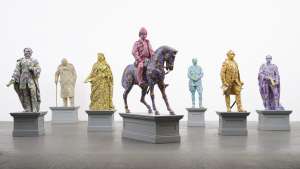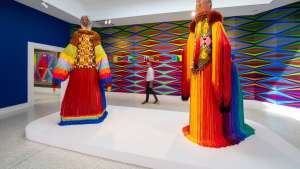Design partners and undergraduates at the Berlin University of Arts Anna Koppmann and Esmée Willemsen are working with old technologies to create a brand-new heating and cooling system for homes. Their thesis project Plus Minus 25 looks into how phase changing material (PCM) can be integrated into curtains that could keep domestic spaces home.
Both Koppmann and Willemsen were concerned with how climate change is affecting global temperature. They began investigating old technologies that were used to heat and cool space, hoping to uncover a low tech, sustainable and affordable option for modern homes. They’re research led them to PCM, and they knew immediately that this semi-forgotten material had great potential.
PCM is a substance that stores and releases thermal energy when changing phases from solid to liquid. It can be used in thermal storage systems and is already commonly used in refrigerators and in ice packs.
“Centuries ago water was used as a PCM in the basement of buildings. When the ice slowly turned to a liquid state during summer, food was kept fresh. In winter it froze and released energy to the building in form of heat,” explained Willemsen.

Koppman and Willemsen found out that PCM was being utilised by the Futurium Museum in Berlin to regulate the building temperature and were excited to learn that it was already being used by the construction industry.
“This opened new applications. We found that PCM is available in a micro-encapsulated form which makes it possible to mix it with other building materials. That discovery was amazing because it enabled us to mix the material with paint and print it on a fabric,” said Koppmann.
This realisation led to their final Plus Minus 25, a temperature regulating curtain. The fabric of the curtain is printed with PCM that absorbs and releases heat to have a cooling effect in summer and a warming effect in winter, without using conventional devices or using any electricity.
The PCM used in the prototypes for Plus Minus 25 is active at 25 degrees Celsius. Around this temperature the PCM starts to melt. During this melting process it cools the air around it, and as the temperature drops it hardens again. The melting temperature can be adjusted, and the material can be applied with different thicknesses for different climates.
Koppmann and Willemsen have been selected to be part of the antenna 2020 conference during Dutch Design Week, where 10 global graduates from across the world will share their ambitious and ground-breaking projects. Ahead of their talk, we had a chat with the two young designers.
Design Indaba: What is your definition of design?
Esmée Willemsen: Design is a tool to shape the world
Anna Koppmann: Design is always political.
How do you think design can be used as a tool for change?
EW: Designers have to understand that they have a responsibility with their work and the things they create as it always has an impact in some way.
In our opinion, new products for our globalised world should be inclusive and be conscious on a social, sustainable, economic and ecological level.
Do you think design is a very individual expression?
AK: I think we live in a world where everything is more connected than ever. The big problems we face are mostly global. There is no way for a designer to disconnect from that.
We all come from different backgrounds and have individual views and opinions, which is great and healthy. By combining these we can find new and individual solutions for global problems. The discourse and exchange of experiences always opens one's own horizon.
What are your design ethics?
- Less waste in production and after
- Less energy usage
- Durability
- Transparency
- Optimism
Should products always be ‘useful’?
EW: We live in a world where we have to much stuff, so I would say the new things we make had better be useful. But ‘useful’ is a very broad phrase. There can also be a symbolic usefulness. But clearly products should not create new needs.
Can Plus Minus 25 be scaled quickly and easily?
AK: Since we are using a conventional method of applying the PCM to textile (screen printing) it can be easily adapted by any textile producer. The producers won’t have to change anything.
For now, our curtains only exist as prototypes and are not production ready. But our wish is to make it accessible to as many people as possible.
How useful are constraints in the design process? And what were your main constraints with this project?
AK: Budget. Basically, having not much money to spend. We were forced to look for people to help make the project possible. We found very enthusiastic professionals who advised us throughout our process and saw potential in our ideas.
EW: And because we could get feedback from a professional company, we could somehow can measure if our ideas were realistic. These professionals were so impressed by our work that they published a case study on us. We got the feeling our products could have a market.
Were you forced to make any compromises?
EW: We wanted to make an elegant and subtle product, and therefore we had to think about how to apply the PCM to the curtain as effectively as possible. As you can imagine, the more PCM that’s used, the greater the effect is. But the more material that is on the fabric, the less it behaves like ‘fabric’.
What is your ultimate design piece, if you had to congratulate one designer for one design – what would it be?
EW: Christien Meindertsma – Flax Project
AK: Marjan van Aubel – The current window
Who would your dream client be?
Kvadrat







